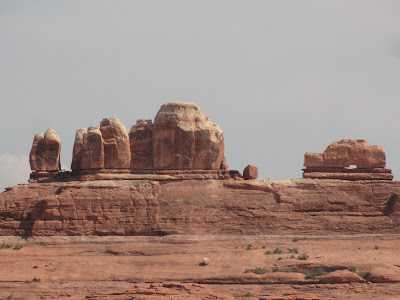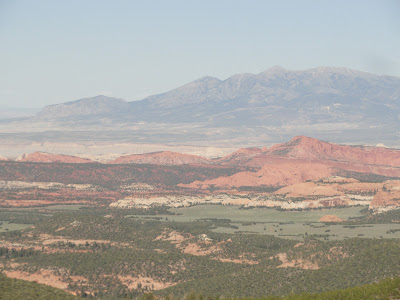You can run and run away from civilization and still, once you're around it, you can't resist. At least that's how it worked for us. For over two weeks the most civilized places we visited were visitors centers in different national and state parks (we feel like home there!). And now we were just around the corner from a town of five thousand inhabitants!!! Not bad considering we're still in Utah.
Those five thousand take care of millions that come to Arches, Canyonlands, Dead Horse Point State Park, for Colorado river rafting and last but not least biking along many bike trails in the area. Moab doesn't even show off anymore with two biggest attractions, namely Arches and Canyonlands. It focuses on advertising those bikes and rafting, with quite good results, it seems. We didn't try though. We didn't even ask for prices, but 100 USD per day of rafting or 40 USD per day of bike rental would probably be a nice surprise. With our budget we could go shopping to Family Dollar and drink coffee for an hour using internet.
As Moab is so "civilized" it was not so easy with free camping either. There is a place we stopped at, called Willow Spring Road. We knew about it from The Frugal Shunpiker's Guide to Southern Utah. It's 8 miles north of Moab, on the east side of "191". Campsites start less than a mile from the highway. Best are on the left but they were occupied, so we took one on the right a little bit further. Marianne warned not to go further than couple of miles as the road gets really sandy. In theory it leads to Arches but we're not sure whether you can actually acces the park this way. Be prepared that it won't be very quite as "191" is a busy road and there is a railroad track next to it.
There are some places on "313", road leading to Island in The Sky. You can follow these instructions: after 8 miles take Mineral Bottom Road and then road leading to Lone Mesa or keep going 8-20 mil straight on Mineral Bottom Road.
We haven't been there so we don't know what it looks like, the above is what Marianne wrote in her Utah guide book, warning at the same time that it's a long and bumpy road. Just make sure to stay in designated area marked by signs with white tent on brown background. Although this might have changed so if you want to explore the area camping-wise visit BLM office in Moab first.
There is a lot of cheap campgrounds (around 10 USD) by "128" along Colorado river which goes right just north from Moab. The road itself is very picturesque as it goes in river canyon and is surrounded by high rock on both sides. It's worth to take a ride. You can also try "279", which goes from "191" in opposite direction, 3 miles north from Moab, just passed Moab Bridge. On 36-mile loop there are natural arches, dinasour traces and rock paintings. Unfortunately (especially for Maciek) we didn't have enough time to go there.
As far as the camping by Colorado river goes, it's not for us. Why pay for something we can have for free? (ok, some of the campsites by the river have vault toilets, but so do we, in the trailer), besides, when we took a ride we found out the road is pretty busy and campgrounds are full of people.
Moab attracts people who need internet to update blog and send some e-mails to family. On the first day we wanted to stock on food and find post office. We ended up seeing a signpost to Needles, which is the most southern part of Canyonlands and...we went there. It was just 40 miles one way...
We were amazed and dissapointed at the same time by Needles. Amazed by the views. Not even the park views, as the park, oh well, as beautiful as any other in Utah. We were amazed by the views from Needles Overlook, another extra twenty something miles one way. But the view from there will stay with us forever. From some 5000 feet high you get the view to tens of miles of cland carved by Colorado and Green rivers. Canyons, cliffs, thins, mesas and snow-capped peaks far away.
When we got there Kalina and Maciek were asleep exhausted by hiking around The Needles. So we took turnes at going to the viewpoint and there, at the canyon rim we were running back and forth trying to understand what mother nature painted in front of our eyes. The view is even more dramatic as the view point is on top of a very high cliff. There are rivers winding far below. The place where Green River meets Colorado is a junction of all three parts of Canyonlands: The Maze, Island in the Sky and The Needles.
Kids woke up 20 minutes after we got there (ok, we helped him a little) and we could show them this amazing view. We loved it so much that we ended up shopping in Moab just before closing time (9 pm), we used internet at Wendy’s (at 10 pm we were the last customers, all the teenagers working there and their friends were looking at us expectatly...). We got back to the trailer around 11 pm.
And what about The Needles? Trademark of this part of Canyonlands are needles, thin, vertical rock formations colored orange, sand, brown - typical Utah colors. Practically the problems with The Needles, at least for people with two kids is, that the needles are far away unless you go on a really long hike. There is of course a scenic drive to Big Spring Canyon Overlook, but the canyon itself, even though it is pretty, with nice rocks and some shade, doesn't have too many needles either.
Nice needles view is a serious hike. Druid Arch is strongly recommended, but it's 11-mile loop including steep climbing. The Green and Colorado River Overlook Trail is pretty much the same lenght. Some visitors do those trails in two days (doing some smaller walks too) camping somewhere under stars (permit required of course). Great idea, even with kids, maybe just a bit older than ours.
And what if you have a sweet monster kicking around in a snuggly and sometimes happy sometimes cranky almost-4-year-old? On top of scenic drive there are a few more easy hikes. One of them is Pot Holes Trail, which is a walk on top of flat, open snadstone, where rain carved holes. Another one is Cave Spring Trail, less than a mile loop along a similar rock but this time it's carved by water from the bottom so it looks almost like an arcade.
Cave Spring is a spring flowing out of the water, place that was inhabited long time ago by ancient Indian people, and then by cowboys taking advantage of green valleys of Colorado and Green River. There is even some furniture from cowboy times, some cans with bullet holes lying around (they look old but who knows)... It looks like a free campsite but a fence and a "do not touch" sign require respect. Maciek really liked it, especially due to the ladders we had to climb on a few parts of a trail and rock paintings - he seems to enjoy them a lot anywhere we see them.
Another attraction of The Needles is… the road to The Needles. It's really nice in Utah that distances don't mean a thing as no matter how far you go the roads are always scenic and picturesque. "191" from Moab is Utah-standard. And "212", that leads directly to the park is a real pleasure for eyes. Rock formation we called icebreakers, cliff walls looking like middle-eastern temples and on top of that a Newspaper Rock.
Newspaper Rock is a rock used for hundered years by peoples of different cultures to leave traces of their presence. There is a fence so you can't get too close, but still you can find on it a spaceship and a peace sign. . It's a must-see on a way to (or from) The Needles. Just next to it there are some trailheads mostly going into riverbeds. Most of them are long and difficult. We thought maybe they'd have some leaflets or maps in The Needles but they said BLM is in charge and they sent us to BLM office in Moab. It would be really nice if NPS and BLM could communicate just a little bit in this area...
Overall if we did it again we'd skip The Needles. If you take a southern route to Moab and you pass by it's worth to go those extra 35 miles to see them. Those with no kids who can hike more than us will probably not leave disappointed at all, but going there from Moab with two little kids was not the best idea ever. Even the view point which was really amazing is comparable to Island in the Sky and Dead Horse Point State Park. Newspaper Rock and the "212" are something worth seeing though.
At the end of this part Pawel would like to invite you to the workshop on "How to write 3.5 pages about a place not really worth seeing with kids cause it's too far and stuff unless you realize it might be once in a lifetime that you're in Utah".
At the end of this part Pawel would like to invite you to the workshop on "How to write 3.5 pages about a place not really worth seeing with kids cause it's too far and stuff unless you realize it might be once in a lifetime that you're in Utah".
One practical tip. We went to The Needles almost without any water, hoping that we'd fill up our bottles there. We did, no problem, but water from The Needles was almost as disgusting as water from Goblins. It tasted as if someone kept it in a plastic bottle left in the sun for much too long. Half of eight feet had some stomach problems afterwards. We're not sure if it was the water or too much civilization but just in case it's good to fill up your bottles somewhere else.



























































